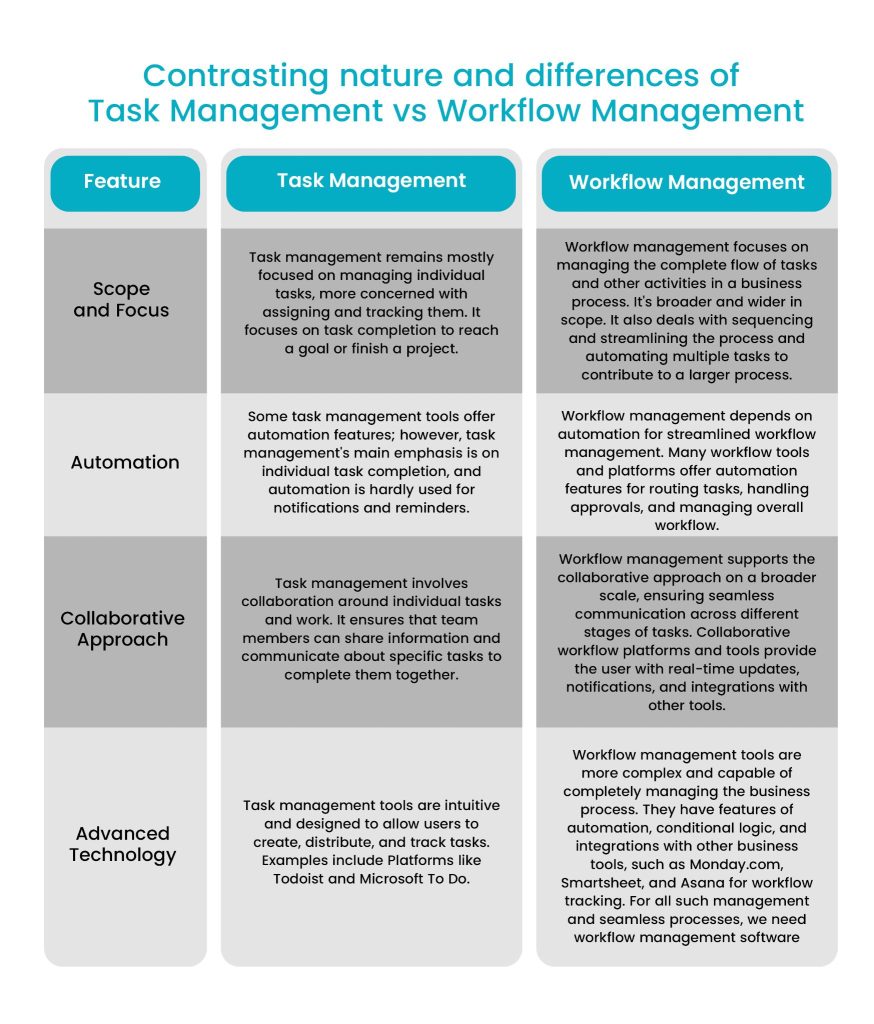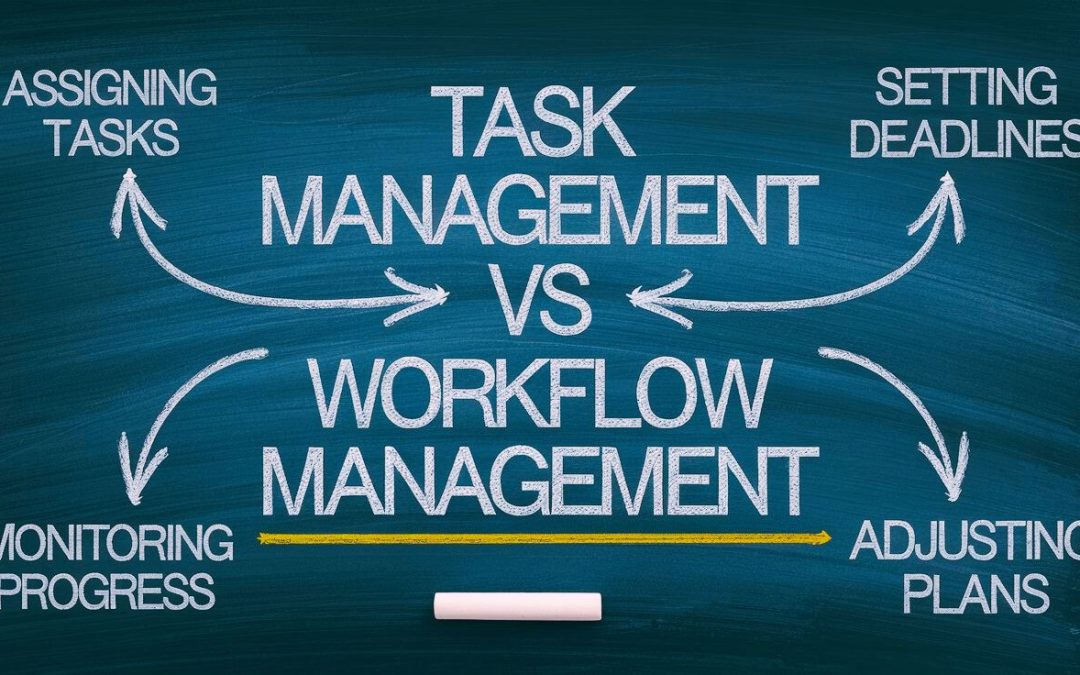Introduction
Task management vs workflow management has become a crucial strategy for businesses in this modern and digital era, as organizations are constantly looking to boost their productivity and efficiency. The working atmosphere has become completely competitive and fast-moving, turning into a tedious process of task completion and managing the workflow. These are the 2 most significant components that allow a business to grow better than its competitors.
Task management and workflow management are constantly used in organizations, representing an approach to solutions for directing working tasks.
Task management vs workflow management has been a crucial strategy for businesses, allowing them to choose an appropriate approach for their working operations and finish them smoothly. In this article, we are going to discuss and explore task management vs workflow management more, as well as its definitions, features, differences, advantages, and capability to fulfill different business requirements. We shall discuss which management method could have more of an impact on business performance.
What is Task Management?
Task management is a process of managing and organizing specific tasks to perform in a project. Some specific and complex tasks, like creation, assignment, tracking, and completion, need to be managed, and they come under the umbrella term of task management. In particular, task management focuses on each task individually to approach a goal successfully. Moreover, it ensures that all the tasks for a project are organized and completed on time by the expert and appointed individual.
Key features of Task Management
Creating and assigning tasks: The initial step is to create a task that must be completed on a priority basis. After that, the task is assigned to a specified individual or to a team based on availability, skills, and expertise. Such assigning and task ownership improve accountability.
Prioritization: Every task must be assigned based on its urgency and importance, allowing the team to assign critical tasks first.
Performance Monitoring: Each task’s progress must be tracked to ensure completion within the deadlines.
Review: After completion, tasks are reviewed to ensure that the work meets the required standards and does not contain errors. This allows the reviewer to analyze the work and check for any room for improvement.
All these functions can be performed using task management tools and software.
What is workflow management?
Workflow management is a process of managing the flow of different tasks and activities in business projects. It refers to performing a series of tasks that need to be completed in a specific order to achieve a particular outcome. Workflow management includes defining, designing, executing work, and monitoring workflows to ensure the work has a definite path with a starting and finishing point. In seeking a specific outcome, multiple tasks, decisions, and approvals take place either in a sequence or parallel under workflow management.
Key features of workflow management
Process Definition: Defining a business process, brainstorming a special sequence of task completion, designing workflow mapping techniques and strategies to achieve optimum results, and distinguishing dependencies between them.
Automation: Automation is an important part of workflow, where steps are taken automatically based on a set of standards and predefined rules. Automation decreases the need for manual checking and intervention, improves efficiency, and allows streamlined workflow management.
Task Routing and Collaborative Approach: In workflow management, tasks are routed to the skilled and expert individual or department every time to ensure they are done by the right people at the right time. Secondly, there are collaborative workflow platforms that ensure that the tasks have been done by different teams or departments in a collaborative approach, sharing information and progress with one another seamlessly.
Progress tracking and reporting: Like task management, workflow management also includes features for tracking task progress, generating reports, and reviewing completed tasks to optimize the process.
Contrasting nature and differences of Task Management vs Workflow Management
While Task Management and Workflow management both focus on managing tasks and different processes, there are specific primary areas where they differ significantly. Let’s begin with some of their key differences.
Scope and Focus
The primary difference between Task management and workflow management lies in its scope and focus.
Task management
Task management remains mostly focused on managing individual tasks, but it is more concerned with assigning and tracking them. It focuses on task completion to reach a goal or finish a project.
Workflow management
Workflow management focuses on managing the complete flow of tasks and other activities in a business process. It’s broader and wider in scope. It also deals with sequencing and streamlining the process and automating multiple tasks to contribute to a larger process.
Automation
Another difference between task management and workflow management is the type of automation and which tasks are automated.
Some task management tools offer automation features; however, task management’s main emphasis is on individual task completion, and automation is hardly used for notifications and reminders.
Workflow management depends on automation for streamlined workflow management. Many workflow tools and platforms offer automation features for routing tasks, handling approvals, and managing overall workflow.
Collaborative Approach
Task management vs workflow management has different approaches regarding the performance and tracking of tasks.
Task management involves collaboration around individual tasks and work. It ensures that team members can share information and communicate about specific tasks to complete them together.
Workflow management supports the collaborative approach on a broader scale, ensuring seamless communication across different stages of tasks. Collaborative workflow platforms and tools provide the user with real-time updates, notifications, and integrations with other tools.
Advanced Technology
The technological differences between task management and workflow management have been very different, and that’s what makes both of these management techniques special.
Task management tools are intuitive and designed to allow users to create, distribute, and track tasks. Examples include Platforms like Todoist and Microsoft To Do.
Workflow management tools are more complex and capable of completely managing the business process. They have features of automation, conditional logic, and integrations with other business tools, such as Opscheck, Monday.com, Smartsheet, and Asana for workflow tracking.
For all such management and seamless processes, we need workflow management software to perform such actions without errors or bugs.

Workflow management software
It is a type of digital tool, a solution created to help businesses automate tasks and manage and optimize their workflow system. It streamlines the whole workflow management system to help a business define, track progress, and execute workflow. Such software eventually increases a business’s productivity.
Features of Workflow Efficiency Solutions
A workflow efficiency solution must have vital features that will help a business project grow and boost its productivity.
Automation of Tasks: It should automate repetitive tasks and allow work to progress in a streamlined manner without manual intervention, which leads to reduced errors, increased time, and operational efficiency. It also includes sending reminders, notifications, task routing, and other minor processes.
Task Routing: It allows you to create a workflow system that automatically assigns tasks to the right team and people. For example, as one person finishes his task, the system will automatically assign him or his team the next task. This feature is highly important for workflow lifecycle management as it allows the workflow cycle to run smoothly.
Collaboration with tools: Workflow management software features collaboration and integration with different business tools, such as comments and document sharing, which allows the whole team to be notified about the progression of tasks. Along with the team, stakeholders also remain aware of any new updates or changes made during the process.
Monitoring of Task Performance: These solutions can monitor all the progress of the task and work being done, providing review reports about team performance. This allows the managers to analyze progress and review reports, optimize the results, and enhance the team’s efficiency.
Benefits of workflow management software
Enhanced efficiency: Automating task routing, reducing manual interventions, and reducing errors and delays improve overall efficiency.
Consistency: Predefined and standard criteria for workflow and overall business ensure that all the processes are executed in the same manner, leading to better and more consistent results.
Transparency: Such software gives users complete transparency about the progress of every task, a clear view of timelines, and enables better project tracking and monitoring.
Cost-effective: By decreasing manual work, reducing errors and delays, and boosting overall efficiency, these solutions allow businesses to save time and high operational costs.
Examples of Workflow efficiency solutions
OpsCheck: OpsCheck is a powerful operational management platform designed to streamline workflows and optimize processes. In addition, it provides users with the ability to automate task tracking, monitor performance, and ensure consistent results across teams. By centralizing operations in one system, OpsCheck helps teams collaborate effectively and maintain smooth, efficient workflows. As a result, it enhances overall productivity and ensures seamless team coordination.
Monday.com: This is a very famous project management software with a workflow automation feature. It allows users to create workflows, track task performance and progress, and collaborate with other teams.
Trello is an intuitive platform that helps teams manage tasks with boards, lists, and cards. It offers customization options to suit different work environments.
Asana is a comprehensive project management tool that enables teams to define, assign, execute, and track tasks in a collaborative setting.
Zoho Creator is a customizable workflow automation solution that lets businesses design and automate tasks across different departments for seamless project management.
Which to choose?
Every business manager must understand the key differences between task management vs workflow management when deciding between them. Managers should be aware of the nature and complexity of their tasks and work, and which kind of solution is suitable for their business growth.
Task management tools are highly suitable for simple and individual tasks. They are ideal for small teams.
On the other hand, task management vs workflow management shows that workflow management is the best choice to handle systems for more complex and multipurpose tasks and processes. It requires coordination, collaboration, and automated tasks, making it ideal for such activities.
Conclusion
In this whole article on task management vs workflow management, the selection of either option ultimately depends on the size, complexity, and nature of the tasks and activities you are organizing. As mentioned earlier, task management is best for managing individual tasks and enhancing productivity. Therefore, understanding these factors is crucial when choosing the right approach for your needs. However, workflow management is perfect for broader and wider-scale processes and tasks that require high-level coordination across different teams.
Every business must understand these key differences in task management vs workflow management before choosing any management solution and then implement its own strategies to boost the team’s performance and productivity.
FAQs
Task management prioritizes tasks, tracks their performance, and reviews them after completion. Workflow management performs a variety of activities in automation and streamlined processes, reducing delays and improving overall productivity.
Yes, one of the essential features of workflow management software is its integration and collaboration with other business tools. This allows seamless communication and data sharing across platforms. Additionally, it enhances team coordination and streamlines processes. As a result, businesses can work more efficiently and avoid silos.
The automation process, task assigning and routing, and collaboration with other tools are key features of workflow management software. Furthermore, it enables monitoring and tracking of task progress in real-time. As a result, this helps ensure efficiency and transparency throughout the workflow. Ultimately, it leads to improved productivity and better coordination among teams.
Yes, it is suitable because it can break down large, complex projects into manageable tasks in larger organizations. It also enhances collaboration and is aligned with organizational goals.


